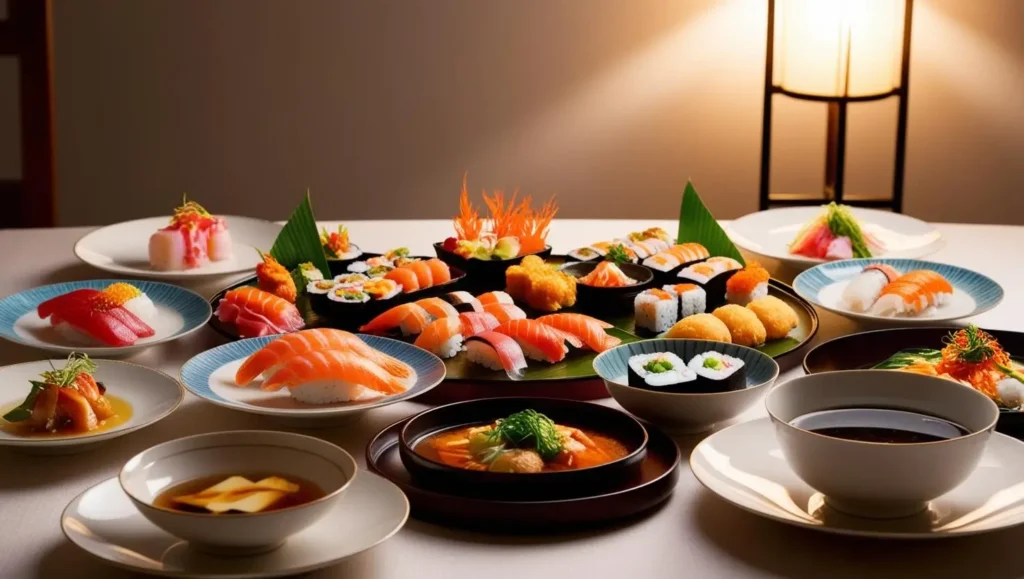Few cuisines balance elegance and comfort quite the way Japanese food does. With its subtle flavors, artful presentation, and attention to seasonal ingredients, Japanese cooking transforms even the simplest meal into something delightful. What many people don’t realize is how approachable Japanese dinner recipes can be, even with a busy weeknight schedule. While some traditional dishes might require special equipment or hard-to-find ingredients, you’d be surprised how many classics can be created with pantry staples and a quick trip to the grocery store.
Let’s open the kitchen door to nine Japanese dinner dishes that strike that sweet spot: achievable, streamlined, and packed with flavor. Whether you’re craving a lighter bite or a heartier comfort meal, there’s something here for everyone.
Bringing Japan to Your Dinner Table
Part of what makes Japanese cooking so special is the sheer range of flavors and textures. From the savory depth of miso soup to the satisfying crispness of tempura, there’s a dish for every mood.
One element you’ll notice: balance is key. Meals typically combine rice, soup, vegetables, and some protein to create a feast for all the senses. Even the simplest dishes feel thoughtful.
Here are a few ingredients that show up often in Japanese home cooking:
- Soy sauce
- Mirin (sweet cooking sake)
- Miso paste
- Dashi (broth base, often made from seaweed and bonito flakes)
- Sake
- Sesame oil
- Tofu
- Rice vinegar
You don’t need to have every fancy bottle on hand. For most recipes, a few essentials are enough to recreate those classic flavors.
1. Chicken Teriyaki
A global favorite with good reason, this dish keeps things simple and punchy. Boneless chicken thighs or breasts are pan-seared, then glazed with a quick sauce of soy, sake, mirin, and a touch of sugar.
Serve over steamed white rice, and sprinkle with some sliced scallion or sesame seeds. Customize with broccoli or green beans on the side for extra color.
- Estimated time: 20–25 minutes
- Pro tip: Simmer the sauce until thickened to coat the chicken beautifully.
2. Salmon Shioyaki (Salt-Grilled Salmon)
Few things taste as soothing as perfectly cooked salmon with crispy skin and a sprinkle of salt. Shioyaki is a study in simplicity, highlighting good-quality fish. Rub the fillets with salt, let them sit for 10 minutes, then grill, broil, or roast until the flesh is just cooked through.
Pair with a bowl of miso soup and a scoop of steamed rice for a meal brimming with quiet joy.
3. Gyudon (Beef Bowl)
If you have thinly sliced beef (often available in the frozen section of Asian grocery stores), gyudon deserves a spot in your dinner rotation. Sauté the beef with onions, then simmer briefly in a sauce of soy, sugar, mirin, and dashi or water.
Ladle the tender beef and onions over a bowl of steaming rice. A lightly cooked egg on top is totally optional but highly encouraged.
- Can be prepped in under 30 minutes.
- Great for meal prep and leftovers.
4. Yakisoba (Stir-Fried Noodles)
This street food classic is weeknight gold. Soft, chewy noodles are stir-fried with pork (or chicken, or tofu), cabbage, and carrot, then tossed with a tangy-sweet sauce. The sauce usually combines Worcestershire, ketchup, oyster sauce, and sometimes a pinch of sugar.
Serve hot, topped with pickled ginger or dried seaweed flakes if you have them.
| Core Ingredients | Replace with | Taste Profile |
|---|---|---|
| Pork slices | Chicken or tofu | Savory, meaty, smoky |
| Yakisoba noodles | Udon, ramen, or egg noodles | Chewy, slurpable |
| Yakisoba sauce | Soy + Worcestershire + ketchup mix | Tangy, sweet, umami |
5. Chicken Katsu
Crunchy breaded chicken, a thick sweet-savory sauce, and a bed of thinly sliced cabbage—this is comfort food at its best. To make katsu, chicken cutlets are dredged in flour, then beaten egg, then panko breadcrumbs, and shallow-fried until golden.
The magic happens when you drizzle with tonkatsu sauce. If unavailable, whisk together ketchup, Worcestershire, soy, and sugar for a quick fix.
- Serve with rice and optional potato salad for a full meal.
6. Tamagoyaki (Rolled Omelette)
Japanese rolled omelette proves that sometimes the humblest ingredients shine brightest. Eggs, lightly sweetened and seasoned with mirin or soy, are rolled layer by layer in a square or rectangular pan, creating a beautiful spiral inside.
Tamagoyaki makes a lovely savory side, but it’s hearty enough for a light meal when paired with vegetables and rice. Leftovers are excellent cold.
7. Nasu Dengaku (Miso-Glazed Eggplant)
Vegetarians, rejoice: nasu dengaku is a satisfying small plate that punches far above its weight in flavor. Halve and score eggplants, then roast or grill until meltingly soft. Glaze with a mixture of miso paste, mirin, sugar, and sake, then broil briefly for an irresistible finish.
Pairs beautifully with a bowl of plain rice, letting the deeply savory glaze shine.
8. Simple Miso Soup
This quick and nourishing soup is a standard in Japanese homes, often served alongside larger meals. It brings together dashi broth (instant dashi is perfect for weeknights), softened miso paste, silken tofu cubes, and sliced green onion.
Add wakame seaweed or mushrooms if you’d like, or keep it bare-bones for simplicity. Sip and feel the day’s stress melt away.
- Ready in 10 minutes
- Can be made vegan by skipping bonito flakes in the dashi
9. Oyakodon (Chicken and Egg Rice Bowl)
The name means “parent and child” donburi, referring to chicken simmered with egg over a bowl of rice. It’s comfort and nostalgia in a single bowl.
Gently poach sliced chicken with onions in a sauce of soy, mirin, and dashi, then pour beaten egg over and let it just set. Spoon the chicken and egg mixture over steamed rice for a one-bowl dinner that feels like a warm hug.
| Donburi Bowl | Main Protein | Extras | Prep Time |
|---|---|---|---|
| Oyakodon | Chicken & egg | Onions, green onion | 20 min |
| Gyudon | Beef | Onion | 30 min |
| Katsudon (variation) | Pork cutlet & egg | Onion, peas | 35 min |
Making Weeknight Japanese Meals Work
Cooking Japanese food at home doesn’t mean spending hours in the kitchen or owning a set of specialty tools. With a few high-impact pantry staples, it’s possible to whip up dinner that tastes both exciting and comforting.
A few approaches that help:
- Using pre-sliced meats or tofu for efficiency
- Leaning on quick sauces from pantry ingredients
- Pairing protein with simple vegetables and rice
- Batch-cooking and storing rice for the week
Don’t be afraid to adjust recipes to your taste. Add in more greens, swap proteins, or double the sauce if you like things extra flavorful.
Trying these recipes is a chance to break the routine and bring some gentle energy to your mealtime. Japanese food offers surprise, calm, and satisfaction, all on one plate. Give one (or several) a try, and let your kitchen become a little brighter.
- Chicken Teriyaki: Pan-seared chicken with a soy, sake, and mirin glaze.
- Salmon Shioyaki: Salt-rubbed salmon with crispy skin.
- Gyudon: Thinly sliced beef and onions over rice.
- Yakisoba: Stir-fried noodles with pork and vegetables.
- Chicken Katsu: Breaded chicken with tonkatsu sauce.
- Simple Miso Soup: Dashi broth with miso and tofu.
FAQ: Japanese Dinner Recipes
As you embark on your culinary journey through Japanese dinner recipes, you might have a few questions. Whether you’re curious about ingredients or seeking shortcuts, we’re here to guide you with confidence and clarity.
What are the essential ingredients for Japanese cooking?
The staples include soy sauce, mirin, miso paste, dashi, sake, sesame oil, tofu, and rice vinegar.
How can I simplify these recipes for a busy weeknight?
Use pre-sliced meats or keep quick sauces ready. Pair proteins with simple vegetables and batch-cook rice.
Can I substitute ingredients in these recipes?
Absolutely! Swap proteins or add more vegetables to suit your taste. Experiment with available ingredients to create your version of these dishes.
Are these recipes suitable for beginners?
Yes, these recipes are approachable and designed to fit into busy schedules, making them perfect for beginners and seasoned cooks alike.
Can I make these dishes vegetarian-friendly?
Many recipes, like Nasu Dengaku and Miso Soup, are easily adaptable by skipping meat or using tofu.
How can I enhance the flavors in these recipes?
Adjust seasoning levels to your preference, double sauce quantities, or incorporate additional herbs and spices.
Is special equipment required for these dishes?
Most of these recipes can be prepared with standard kitchen tools, making them accessible to everyone.


